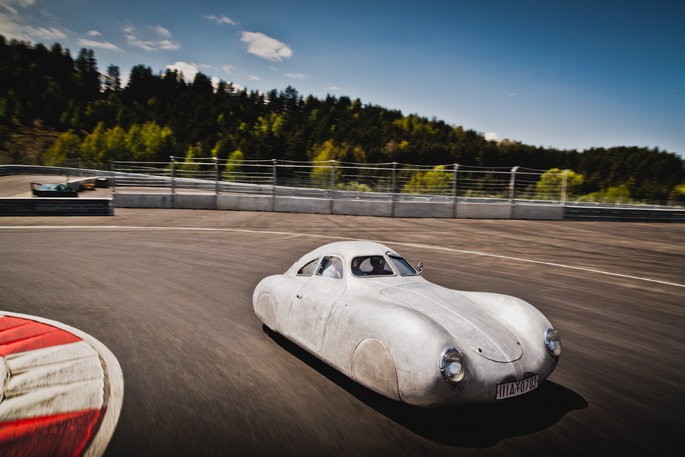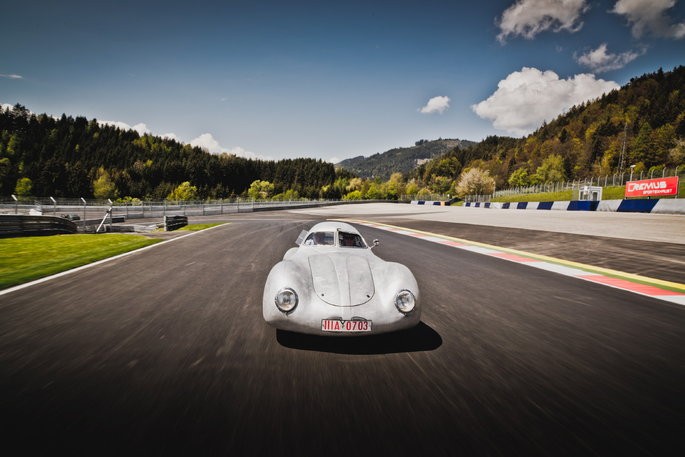With his streamlined coupé built for the Berlin-Rome long distance race in 1939, Ferdinand Porsche had already revealed his skills in aerodynamics and sports car design. The Austrian Michael Barbach has created a replica of the legendary Berlin-Rom racing car - and in paying homage to the car has invested no less than 9,000 hours of work.
The word replica is not one that is used gladly by car collectors and connoisseurs – after all, authenticity and “matching numbers” are among the most important and most valuable qualities a classic car can possess. And yet there are cars, the histories of which appear so complex and unique, and of which there are very few examples left, that a replica would appear to be more than welcome. One such example is Porsche‘s legendary vehicle. Developed in the early months of 1939 by Ferdinand Porsche in his design office, the unusually shaped coupé, which was based on the KdF vehicle, was built to participate in what was obviously a politically motivated autobahn race from national socialist Berlin to Rome, which at that time was governed by the fascists. But the outbreak of war put an end to such plans – and the streamlined vehicle ended up becoming a unique and fascinating curiosity. Like many other car engineers of his time, Ferdinand Porsche, a car racing enthusiast, fell prey to the new aerodynamics bug in the 1920s and 1930s and set about developing a streamlined, aerodynamic vehicle of his own based on aeronautical principles. The sports coupé with its curvaceous aluminium body, the narrow cockpit and the covered wheel arches may seem a little weird today – and yet it was not only in line with the state of the art at that time, but it also laid the foundation for the flat, curving silhouette that was later to write design history with the Porsche 356, and ultimately the Porsche 911.
Three examples of the Porsche Type 64 – the project designation – were built in accordance with the rules of the Berlin-Rome race and completed further testing during the war. From the early 1940s, however, the fate of the three streamlined cars becomes blurred. Were two examples destroyed by bombs and accidents? Or were they cannibalised as spare part donors? Sources contradict each other. The only thing that appears certain is that at least one car survived and was driven in the years following the war by Ferdinand Porsche’s son Ferry. In the summer of 1949, it was the Austrian racing driver Otto Mathé who finally bought the wayward rear-engined coupé and in the coming years entered it successfully in numerous races. Mathé owned the Berlin-Rome car until he died in 1995, after constantly changing the set-up of the car and installing new technology and engines. After Mathé‘s death, racing driver Thomas Gruber bought the unusual car and had it returned to its original condition by specialist Michael Barbach. When the restored version of the original changed owners once again in 2008, car restorer Barbach decided to begin with the development of his own replica of the very first Berlin-Rome racing car. Since there were very few design drawings available from those early days and there were virtually no spare parts around, the reconstruction turned out to be far more complicated than expected. The body shell was hammered into shape by hand, window panes bent by artists, lights and numerous small parts reproduced in detailed, time-consuming work. After a total of some 9,000 hours of work, the streamlined Porsche was finally mounted on its wheels in May 2014 – and since then has not only been an eye-catcher at historical events, but remains an impressive reminder of the pioneering days of motoring and the early years of Porsche.
(c) Text: Jan Baedeker, Fotos: Stefan Bogner















